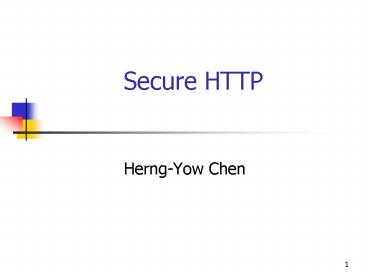Secure HTTP - PowerPoint PPT Presentation
1 / 31
Title:
Secure HTTP
Description:
How a more complicated technology secures HTTP transactions from ... Jone doe. Certificate issuer signature. RSA Data Security. Certificate issuer name ... – PowerPoint PPT presentation
Number of Views:954
Avg rating:3.0/5.0
Title: Secure HTTP
1
Secure HTTP
- Herng-Yow Chen
2
Outline
- When digest authentication is not strong enough?
- How a more complicated technology secures HTTP
transactions from eavesdropping and tampering? - Using digital cryptography.
3
HTTPS
https scheme
security icon
4
HTTPS (cont.)
H T T P
Application layer
H T T P
Application layer
SSL or TLS
Security layer
T C P
Transport layer
T C P
Transport layer
Network layer
I P
I P
Network layer
Network interfaces
Network interfaces
Data link layer
Data link layer
(b) HTTPS
(a) HTTP
5
Digital cryptography
- Ciphers
- Keys
- Symmetric-key cryptosystems
- Asymmetric-key cryptosystems
- Public-key cryptography
- Digital signatures
- Digital certificates
6
Plaintext and Ciphertext
Plaintext
Ciphertext
Phhw ph dw wkh slhu dw plgqljkw
Meet me at the pier at midnight
Encoder
Plaintext
Meet me at the pier at midnight
Decoder
7
Rotate-by-3 cipher example
8
Keyed Ciphers (rotate-by-n), using different keys
Meet me at the pier at midnight
Plaintext
(a)
Ciphertext
nffu nf bu uif qjfs bu njeojhiu
Key1
Rotate(n) encoder
Meet me at the pier at midnight
Plaintext
(b)
Ciphertext
oggv og cv vjg rkgt cv okfpkijv
Key2
Rotate(n) encoder
Meet me at the pier at midnight
Plaintext
(c)
Ciphertext
phhw ph dw wkh slhu dw plgqlijkw
Key3
Rotate(n) encoder
9
Digital Ciphers
10
Plaintext is encoded with encoding key e
Plaintext P
C E (P, e)
Keye
Ciphertext C
Encoder E
11
Symmetric-Key Cryptography
If d e
Ciphertext C
P D (C, d)
Keyd
Plaintext P
Decoder D
Popular symmetric-key cryptography algorithm are
DES, Triple-DES, RC2, and RC4.
12
Key Length and Enumeration Attacks
13
Public-Key Cryptography
Using different keys for encoding and decoding
client
Plaintext
Private keyds
Public keyes
Encrypted ciphertext
Internet
Plaintext
server
14
Public-Key cryptography assigns a single, public
encoding key to each host
A
A
kAX
ex
B
D
B
D
kBX
kDX
ex
ex
kCX
ex
C
C
(a) Symmetric-key cryptography
(b) Public-key cryptography
15
Signatures Are Cryptographic Checksums
Plaintext message
B
A
Message digest
Message digest
Same?
E
D
Signature
Message digest
Public keyeA
Private keydA
16
The Guts of a Certificate
17
X.509 v3 Certificates
18
Verifying that a signature is real
B
Message digest
Message digest
Same?
E
Signing authoritys public key
19
HTTPS Overview
H T T P
Application layer
H T T P
Application layer
SSL or TLS
Security layer
T C P
Transport layer
T C P
Transport layer
Network layer
I P
I P
Network layer
Network interfaces
Network interfaces
Data link layer
Data link layer
(b) HTTPS
(a) HTTP
20
HTTPS Schemes
(a) HTTP request
80
HTTP
Server
client
(b) HTTPS request
443
HTTPS
Secure Server
client
(C) HTTPS over HTTP tunnel
443
8080
HTTPS
client
Secure Server
Proxy
HTTP tunnel
21
Secure Transport Setup
22
Secure Transport Setup (cont.)
(a) Unencrypted HTTP transaction
(b) Enencrypted HTTPS transaction
23
SSL Handshake (simplified)
24
Server Certificates
HTTPS certificates are X.509 certificates with
site information
Internet
client
Server Certificate
Server
25
Virtual Hosting and Certificates
Certificate name mismatches bring up certificate
error dialog boxes
26
Virtual Hosting and Certificates (cont.)
27
Tunneling Secure Traffic Through Proxies
Corporate firewall proxy
client
Public Internet
client
Firewall proxy
Security perimeter
28
Tunneling Secure Traffic Through Proxies (cont.)
Proxy cannot proxy an encrypted request
proxy.ncnu.edu.tw
www.cajun-gifts.com
client.ncnu.edu.tw
bdfwr73ytr6ouydoiw687eqidfjwvd76weti76fig287hdi9 8
r82yr87pfdy72y87193836PDUyqe719eyty3gee98y8787
29
Reference
- HTTP Security
- Web Security, Privacy Commerce
- Simson Garfinkel, Oreilly Associates, Inc.
This is one of the best, most readable
introductions to web security and the use of
SSL/TLS and digital certificates. - http//www.ietf.org/rfc/rfc2818.txt
- RFC 2818, HTTP Over TLS, specifies how to
implement secure HTTP over Transport Layer
Security (TLS), the modern successor to SSL. - http//www.ietf.org/rfc/rfc2246.txt
- RFC 2817, Upgrading to TLS Within HTTP/1.1,
explains hoe to use the Upgrade mechanism in
HTTP/1.1 to initiate TLS over an existing TCP
connection. This allows unsecured and secured
HTTP traffic to share the same well-known port
(in this case, http at 80 rather than https at
443). It also enables virtual hosting, so a
single HTTPTLS server can disambiguate traffic
intended for several hostnames at a single IP
address.
30
Reference (cont.)
- SSL and TLS
- http//ww.ietf.org/rfc/rfc2246.txt
- RFC 2246, The TLS Protocol Version 1.0,
specifies Version 1.0 of the TLS protocol (the
successor to SSL). TLS provides communications
privacy over the Internet. The protocol allows
client/server applications to communicate in a
way that is designed to prevent eavesdropping,
tampering, and message forgery. - http//developer.netscape.com/docs/manuals/securit
y/sslin/contents.htm - Introduction to SSL introduces the Secure
Sockets Layer (SSL) protocol. Originally
developed by Netscape, SSL has been universally
accepted on the World Wide Web for authenticated
and encrypted communication between clients and
servers. - http//www.netscape.com/eng/ssl3/draft302.txt
- The SSL Protocol Version 3.0 is Netscapes
1996 specification for SSL.
31
Reference (cont.)
- http//developer.netscape.com/tech/security/ssl/ho
witworks.html - How SSL Works is Netscapes introduction to
key cryptography. - http//www.openssl.org
- The OpenSSL Project is a collaborative
effort to - develop a robust, commercial-grade,
full-featured, - and open source toolkit implementing the
Secure - Sockets Layer (SSL v2/v3) and Transport
Layer - Security (TLS v1) protocols, as well as a
full-strength, - general-purpose cryptography library.

